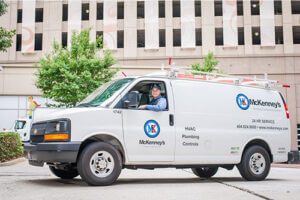
The CDC defines the principal means of COVID-19 transmission to be through droplet transmission. Respiratory droplets are produced when we speak, breathe, laugh, and sing. If you sneeze on someone, this is defined by the CDC as droplet transmission. When this occurs, some small droplets become suspended in the air, while larger droplets fall to the ground. The smaller suspended droplets are what the CDC constitutes as airborne transmission. The CDC has noted that airborne transmission of COVID-19 is only likely under special circumstances where droplets are being produced for extended periods of time (>30 minutes) in an enclosed space.
In a prior blogpost, we discussed utilizing bi-polar ionization to mitigate the spread of COVID-19 utilizing the HVAC system to disperse ions that neutralize the virus. There are still no third-party studies confirming the manufacturer’s claimed efficacy of these bi-polar systems, however the CDC has provided guidance regarding this emerging technology. In a position statement, the CDC recommends that any bi-polar ionization system should meet UL standard 2998, which is provided to systems that produce zero ozone. Ozone is a gas that has disinfecting properties but is hazardous to human health in high concentrations. Ozone was a common byproduct of older bi-polar ionization systems, but newer technologies are able to accomplish this with no ozone generation. A bi-polar ionization system with the UL 2998 listing has been certified to generate no harmful level ozone. The CDC position statement in its entirety can be found in the ASHRAE technical resource on filtration and disinfection. McKenney’s will continue to monitor the ASHRAE guidance on COVID-19 mitigation and how to best serve our customers.
The CDCs stance on COVID-19 spread is that it is still primarily through close contact droplet transmission. Regardless of the HVAC strategies in place, it is important to note that the absolute best way to mitigate your risk of infection is to socially distance, wash your hands, keep your hands away from your eyes, nose and mouth, and wear masks when appropriate.
ADDITIONAL RESOURCES:
- CDC Scientific Brief: SARS-CoV-2 and Potential Airborne Transmission. Oct 5. 2020
- The American Society of Refrigeration and Air-Conditioning Engineers (ASHRAE) developed COVID-19 Preparedness Resources and has established the ASHRAE Epidemic Task Force to respond to the current global COVID-19 pandemic and provide guidance on how to prepare for future epidemics. This task force will address the challenges as it relates to the effects of heating, ventilation, and air-conditioning systems on disease transmission in healthcare facilities, the workplace, home, public and recreational environments. The task force will also provide recommendations for setting up temporary field hospitals in convention centers, arenas, and indoor stadia to deal with surges.
- ASHRAE Technical Resources: Filtration-Disinfection
- McKenney’s Blog: Bipolar Ionization
Have a question for our experts? Leave your comment below and check out our website for more information.




